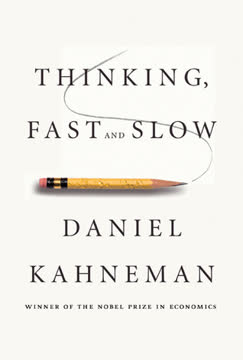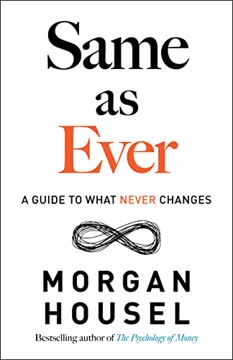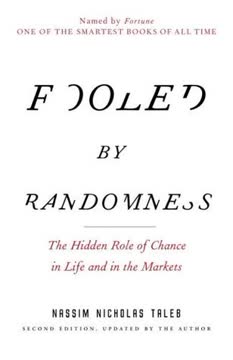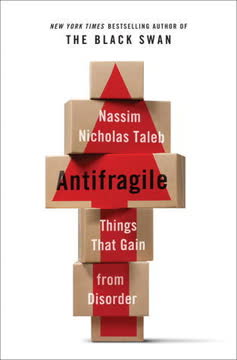نکات کلیدی
1. ضدشکنندگی: شکوفایی در بینظمی و عدم قطعیت
باد شمع را خاموش میکند و آتش را تقویت میکند.
تعریف ضدشکنندگی. ضدشکنندگی ویژگی سیستمهایی است که از شوکها، نوسانات و فشارها بهرهمند میشوند. برخلاف استحکام یا مقاومت که در برابر تغییر مقاومت میکنند، سیستمهای ضدشکننده در مواجهه با بینظمی بهبود مییابند.
نمونههایی از ضدشکنندگی:
- سیستمهای زیستی (مثلاً عضلاتی که با ورزش قویتر میشوند)
- تکامل (گونههایی که به تغییرات محیطی سازگار میشوند)
- سیستمهای اقتصادی (کارآفرینانی که از اختلالات بازار بهرهمند میشوند)
- ایدهها (برخی نظریهها که با چالش قویتر میشوند)
اهمیت ضدشکنندگی. در دنیایی با افزایش عدم قطعیت و پیچیدگی، پرورش ضدشکنندگی برای بقا و موفقیت بلندمدت حیاتی است. با پذیرش نوسانات به جای تلاش برای پیشبینی یا کنترل آن، میتوانیم سیستمهایی بسازیم که نه تنها بقا یابند بلکه در محیطهای آشفته شکوفا شوند.
2. سهگانه: شکننده، مقاوم و ضدشکننده
ضدشکنندگی فراتر از مقاومت یا استحکام است. مقاوم در برابر شوکها مقاومت میکند و همان میماند؛ ضدشکننده بهتر میشود.
درک سهگانه. طالب چارچوبی برای دستهبندی نحوه واکنش چیزها به نوسانات معرفی میکند:
- شکننده: آسیبپذیر در برابر بینظمی (مثلاً یک گلدان ظریف)
- مقاوم: مقاوم در برابر بینظمی (مثلاً یک میز محکم)
- ضدشکننده: بهرهمند از بینظمی (مثلاً سیستم ایمنی انسان)
کاربرد سهگانه. این چارچوب میتواند برای تحلیل حوزههای مختلف استفاده شود:
- سرمایهگذاریهای مالی
- استراتژیهای شغلی
- سیستمهای فناوری
- سیاستهای اجتماعی
با شناسایی جایگاه چیزها در این طیف، میتوانیم تصمیمات بهتری درباره نحوه مواجهه با ریسک و عدم قطعیت در زمینههای مختلف زندگی بگیریم.
3. جبران بیش از حد و هورمسیس: مکانیسمهای ضدشکننده طبیعت
دشواری چیزی است که نبوغ را بیدار میکند.
توضیح جبران بیش از حد. وقتی در معرض فشار قرار میگیرند، بسیاری از سیستمهای طبیعی نه تنها به حالت اولیه خود بازمیگردند بلکه قویتر میشوند. این اصل در موارد زیر مشهود است:
- رشد عضلات پس از وزنهبرداری
- افزایش تراکم استخوان از تمرینات ضربهای
- تقویت سیستم ایمنی پس از مواجهه با پاتوژنها
هورمسیس در عمل. مفهوم هورمسیس نشان میدهد که دوزهای کم از مواد مضر میتوانند اثرات مفیدی داشته باشند. این ایده برای موارد زیر پیامدهایی دارد:
- درمانهای پزشکی
- سازگاریهای محیطی
- استراتژیهای رشد شخصی
با درک و بهرهگیری از این مکانیسمهای ضدشکننده طبیعی، میتوانیم سیستمها و روشهایی طراحی کنیم که از طریق مواجهه با فشارهای کنترلشده قویتر شوند.
4. ویا نگاتیوا: قدرت کاهش و سادگی
هرچه سادهتر، بهتر. پیچیدگیها به زنجیرههای چندگانه از اثرات غیرمنتظره منجر میشوند.
تعریف ویا نگاتیوا. این اصل بر قدرت حذف به جای افزودن تأکید دارد. اغلب، بهبود از طریق حذف چیزها به جای افزودن پیچیدگی بیشتر حاصل میشود.
کاربردهای ویا نگاتیوا:
- سلامت: حذف غذاها یا عادات مضر اغلب مؤثرتر از افزودن مکملها است
- تصمیمگیری: حذف گزینههای بد میتواند قویتر از جستجوی راهحل کامل باشد
- فناوری: سادهسازی سیستمها میتواند به قابلیت اطمینان و اثربخشی بیشتر منجر شود
مزایای سادگی. با پذیرش سادگی و کاهش، میتوانیم:
- عواقب ناخواسته را کاهش دهیم
- وضوح فکر و عمل را بهبود بخشیم
- استحکام و ضدشکنندگی را در سیستمهای مختلف افزایش دهیم
5. انتخابپذیری: کلید تصمیمگیری ضدشکننده
انتخابپذیری ضدشکنندگی است وقتی به درستی استفاده شود.
درک انتخابپذیری. انتخابپذیری به توانایی بهرهبرداری از شرایط مثبت غیرمنتظره در حالی که از شرایط منفی محافظت میشود، اشاره دارد. این درباره داشتن حق، اما نه الزام، برای انجام یک اقدام خاص است.
استراتژیهای افزایش انتخابپذیری:
- حفظ چندین منبع درآمد
- توسعه مجموعه مهارتهای متنوع
- ساخت شبکهای از روابط متنوع
- نگهداری ذخایر نقدی برای فرصتهای غیرمنتظره
مزایای انتخابپذیری. با پرورش انتخابپذیری، میتوانیم:
- از رویدادهای مثبت قوی سیاه بهرهمند شویم
- ریسک نزولی را محدود کنیم
- به راحتی به شرایط متغیر سازگار شویم
- با اطلاعات ناقص تصمیمگیری کنیم
6. پوست در بازی: همترازی انگیزهها و پیامدها
هرگز به کسی که پوست در بازی ندارد اعتماد نکنید. بدون آن، احمقها و کلاهبرداران بهرهمند میشوند و اشتباهاتشان هرگز به سراغشان نمیآید.
توضیح پوست در بازی. این اصل بیان میکند که افراد باید عواقب اعمال و تصمیمات خود را به ویژه زمانی که این اعمال بر دیگران تأثیر میگذارد، تحمل کنند.
اهمیت در حوزههای مختلف:
- مالی: مدیران سرمایهگذاری باید سهام شخصی در صندوقهای خود داشته باشند
- سیاست: سیاستگذاران باید مستقیماً تحت تأثیر سیاستهای خود قرار گیرند
- تجارت: مدیران باید در قبال شکستهای شرکت مسئول باشند
مزایای پوست در بازی:
- انگیزهها را با نتایج همتراز میکند
- خطر اخلاقی را کاهش میدهد
- کیفیت تصمیمگیری را بهبود میبخشد
- اعتماد به سیستمها و نهادها را ایجاد میکند
7. استراتژی هالتر: ترکیب افراطها برای ضدشکنندگی
من ابتدا از تصویر هالتر برای توصیف نگرش دوگانهای استفاده کردم که در برخی حوزهها ایمن بازی میکند (مقاوم در برابر قوی سیاههای منفی) و در دیگر حوزهها ریسکهای کوچک زیادی میپذیرد (باز به قوی سیاههای مثبت)، بنابراین به ضدشکنندگی دست مییابد.
تعریف استراتژی هالتر. این رویکرد شامل ترکیب دو افراط در حالی که از میانه اجتناب میکند، است. این درباره همزمانی فوقالعاده محافظهکار و فوقالعاده تهاجمی بودن است، به جای پذیرش ریسکهای متوسط.
نمونههایی از استراتژیهای هالتر:
- مالی: سرمایهگذاری 90% در داراییهای بسیار ایمن و 10% در داراییهای بسیار پرخطر
- شغلی: حفظ شغل پایدار در حالی که پروژههای جانبی با ریسک بالا و پاداش بالا را دنبال میکند
- آموزشی: تمرکز بر مهارتهای پایه و دانش پیشرفته، اجتناب از میانه
مزایای رویکرد هالتر:
- ریسک نزولی را محدود میکند در حالی که پتانسیل صعودی را حفظ میکند
- ثبات و فرصت رشد را فراهم میکند
- امکان امنیت و نوآوری را فراهم میکند
8. مغالطه پیشبینی و ارزش آزمون و خطا
در دنیایی که منابع قوی سیاهها فراتر از اندازهگیری چند برابر شدهاند، تصمیمات آشکار به شدت خطرناک میشوند.
توضیح مغالطه پیشبینی. طالب استدلال میکند که در سیستمهای پیچیده، پیشبینی دقیق اغلب غیرممکن است و تلاش برای پیشبینی میتواند به شدت گمراهکننده باشد.
جایگزینهای پیشبینی:
- آزمون و خطا: آزمایش و تکرار در مقیاس کوچک
- انتخابپذیری: حفظ انعطافپذیری برای سازگاری با شرایط غیرمنتظره
- برنامهریزی ضدشکننده: طراحی سیستمهایی که از نوسانات بهرهمند شوند
مزایای پذیرش عدم قطعیت:
- کاهش وابستگی به مدلها و پیشبینیهای ناقص
- افزایش سازگاری با شرایط متغیر
- پتانسیل بیشتر برای نوآوری و کشف
9. اندازه مهم است: شکنندگی سیستمهای بزرگ
برای یک شرکت بزرگ، تفاوت بین ورشکستگی و سودآوری ممکن است به کوچکی یک نقطه پایه کاهش هزینه وام باشد.
مشکل اندازه. سیستمهای بزرگ، چه شرکتها، دولتها یا فناوریها، تمایل به شکنندگی بیشتری نسبت به سیستمهای کوچکتر دارند. آنها در برابر رویدادهای قوی سیاه آسیبپذیرتر هستند و کمتر قادر به سازگاری سریع هستند.
دلایل شکنندگی در سیستمهای بزرگ:
- افزایش پیچیدگی و وابستگیها
- دشواری در شناسایی و مدیریت ریسکها
- زمان پاسخدهی کندتر به تغییرات
- تأثیر بیشتر در صورت وقوع شکستها
استراتژیهای مقابله با شکنندگی مرتبط با اندازه:
- تمرکززدایی و مدولار کردن
- حفظ افزونگیها و انعطافپذیری
- تشویق تصمیمگیری محلی و آزمایش
- تقسیم نهادهای بزرگ به واحدهای کوچکتر و قابل مدیریتتر
10. ملاحظات اخلاقی در ضدشکنندگی
ضدشکنندگی به هزینه دیگران ضدشکنندگی نیست، بلکه جرم است.
چارچوب اخلاقی. در حالی که ضدشکنندگی میتواند مفهومی قدرتمند باشد، ضروری است که پیامدهای اخلاقی آن را در نظر بگیریم، به ویژه زمانی که ضدشکنندگی فردی یا سیستمی به هزینه شکنندگی دیگران باشد.
ملاحظات اخلاقی کلیدی:
- انصاف: اطمینان از اینکه استراتژیهای ضدشکننده به طور ناعادلانه به دیگران آسیب نمیرسانند
- شفافیت: باز بودن درباره ریسکها و پیامدهای احتمالی
- مسئولیتپذیری: پذیرش مسئولیت برای اثرات منفی خارجی
- تفکر بلندمدت: در نظر گرفتن تأثیرات اجتماعی گستردهتر سیستمهای ضدشکننده
تعادل بین ضدشکنندگی و اخلاق:
- طراحی سیستمهایی که منافع و ریسکها را به طور عادلانهتری توزیع کنند
- اجرای کنترلها و توازنها برای جلوگیری از سوءاستفاده از موقعیتهای ضدشکننده
- ترویج آموزش و آگاهی درباره ضدشکنندگی و پیامدهای اخلاقی آن
- توسعه سیاستهایی که به استراتژیهای ضدشکننده اخلاقی انگیزه دهند
آخرین بهروزرسانی::
FAQ
What's Antifragile by Nassim Nicholas Taleb about?
- Core Concept: Antifragile explores systems that benefit from volatility and disorder, contrasting with fragile systems that break under stress. Taleb introduces "antifragility" to describe entities that gain from chaos and uncertainty.
- Triad Framework: The book presents a framework categorizing things into fragile, robust, and antifragile, helping readers understand how different systems respond to stressors and uncertainty.
- Real-World Applications: Taleb applies the concept of antifragility across various domains, including economics, medicine, and personal life, arguing that understanding antifragility can lead to better decision-making in uncertain environments.
Why should I read Antifragile by Nassim Nicholas Taleb?
- Unique Perspective on Risk: Taleb offers a fresh viewpoint on risk management, emphasizing the importance of embracing uncertainty rather than avoiding it, which is particularly relevant in today's unpredictable world.
- Practical Insights: The book is filled with practical advice on navigating life and business in a way that leverages antifragility, helping readers improve their resilience and adaptability.
- Engaging Writing Style: Taleb's writing is thought-provoking and entertaining, filled with anecdotes and philosophical musings, making the book both informative and enjoyable to read.
What are the key takeaways of Antifragile by Nassim Nicholas Taleb?
- Embrace Randomness: Taleb argues that randomness and uncertainty are essential for growth and innovation, highlighting the need to harness chaos.
- Avoid Over-Intervention: The book warns against naive interventionism, which can lead to fragility, emphasizing that sometimes doing nothing is the best course of action.
- Barbell Strategy: Taleb introduces the barbell strategy, balancing extreme risk-taking with extreme caution to minimize potential losses while maximizing opportunities for gains.
What is the barbell strategy in Antifragile by Nassim Nicholas Taleb?
- Dual Approach: The barbell strategy involves taking on high-risk opportunities while securing a large portion of assets in safe investments, creating a protective buffer against potential losses.
- Minimizing Risk of Ruin: By allocating resources this way, individuals can avoid the risk of total loss, as the safe portion protects against extreme downturns.
- Flexibility and Adaptability: This strategy allows for flexibility in decision-making, enabling individuals to adapt to changing circumstances without jeopardizing their overall financial health.
How does Antifragile by Nassim Nicholas Taleb define fragility?
- Fragility Explained: Taleb defines fragility as a condition where a system is harmed by volatility and uncertainty, using the metaphor of a fragile package that breaks under stress.
- Asymmetry of Outcomes: Fragile systems have more to lose than to gain, leading to a negative asymmetry, illustrating how fragility can benefit the collective at the expense of the individual.
- Path Dependence: Fragility is often irreversible, meaning that once a fragile system is harmed, it may not recover, highlighting the importance of proactive risk management.
What is the significance of the Triad in Antifragile by Nassim Nicholas Taleb?
- Framework for Understanding: The Triad categorizes systems into fragile, robust, and antifragile, providing a clear framework for analyzing how different entities respond to stressors.
- Guiding Decision-Making: By understanding where a system falls within the Triad, individuals can make more informed decisions about risk management and strategy.
- Application Across Domains: The Triad can be applied to various fields, including economics, health, and personal relationships, making it a valuable tool for navigating complexity in everyday life.
What are some examples of antifragility in Antifragile by Nassim Nicholas Taleb?
- Biological Systems: Taleb discusses how living organisms, such as the human body, exhibit antifragility by becoming stronger through exposure to stressors.
- Economic Systems: He uses the example of small businesses and startups, which are often fragile individually but contribute to a robust and antifragile economy.
- Cultural Practices: Taleb highlights cultural practices that embrace randomness and uncertainty, such as traditional markets that thrive on local variations and competition.
How does Antifragile by Nassim Nicholas Taleb address the concept of iatrogenics?
- Definition of Iatrogenics: Taleb introduces the term iatrogenics to describe harm caused by intervention, particularly in medicine, arguing that unnecessary procedures can lead to worse outcomes.
- Critique of Naive Interventionism: The book critiques the tendency to intervene without understanding the potential consequences, emphasizing that "first, do no harm" should be a guiding principle.
- Call for Awareness: Taleb advocates for greater awareness of the unintended consequences of interventions, urging readers to consider the long-term effects of their actions.
What are the best quotes from Antifragile by Nassim Nicholas Taleb and what do they mean?
- "Wind extinguishes a candle and energizes fire.": This quote encapsulates the core idea of antifragility, suggesting that challenges and chaos can lead to growth and strength.
- "What does not kill me makes me stronger.": Taleb uses this to illustrate that the survival of the fittest often comes at the expense of the weaker, highlighting the dynamics of fragility and antifragility.
- "The probability of the unacceptable (i.e., the risk of ruin) is nil.": This quote emphasizes the importance of minimizing risk through strategic decision-making, reinforcing the idea of protecting against catastrophic losses.
How does Antifragile by Nassim Nicholas Taleb relate to modernity and its challenges?
- Critique of Modernity: Taleb argues that modernity often seeks to eliminate randomness and volatility, leading to fragility in systems, which can result in catastrophic failures when unexpected events occur.
- Call for a Return to Antifragility: The book advocates for embracing uncertainty and allowing systems to thrive on stressors, rather than trying to smooth out all disturbances.
- Implications for Policy and Governance: Taleb warns against top-down interventions that aim to create stability, arguing that they often backfire and create hidden vulnerabilities.
What is the "ludic fallacy" mentioned in Antifragile by Nassim Nicholas Taleb?
- Definition: The ludic fallacy refers to the misconception that the uncertainties we face in real life can be modeled using simplified games or statistical models.
- Implications: This fallacy leads to underestimating risks and overestimating predictability, particularly in financial markets and other complex systems.
- Real-World Examples: Taleb uses examples from finance and economics to illustrate how the ludic fallacy can result in catastrophic failures, emphasizing the need for a more nuanced understanding of risk.
What is the "via negativa" approach in Antifragile by Nassim Nicholas Taleb?
- Focus on Subtraction: The "via negativa" approach emphasizes removing harmful elements rather than adding new ones, often more effective in achieving positive outcomes.
- Application in Medicine: This approach suggests that many interventions may do more harm than good, and sometimes doing nothing is the best course of action.
- Broader Implications: The concept can be applied to various aspects of life, including personal habits, business strategies, and public policy, focusing on what to avoid to create more antifragile systems.
نقد و بررسی
مجموعهی چهار جلدی Incerto اثر نسیم نیکلاس طالب، به بررسی عدم قطعیت، تصادف و تصمیمگیری در سیستمهای پیچیده میپردازد و بسیار مورد تحسین قرار گرفته است. خوانندگان ایدههای اصیل طالب، از جمله مفاهیمی مانند ضدشکنندگی و رویدادهای قوی سیاه را ستایش میکنند. این کتابها بینشهایی دربارهی ریسک، احتمال و هدایت در دنیای غیرقابل پیشبینی ارائه میدهند. در حالی که برخی سبک نگارش طالب را چالشبرانگیز و شخصیت او را تند میدانند، بسیاری این مجموعه را به شدت تأثیرگذار و برانگیزانندهی تفکر میدانند. منتقدان معتقدند که ایدهها میتوانستند به صورت مختصرتر ارائه شوند، اما طرفداران عمق و گستردگی کاوشهای طالب را تحسین میکنند.
Incerto Series
Similar Books




















